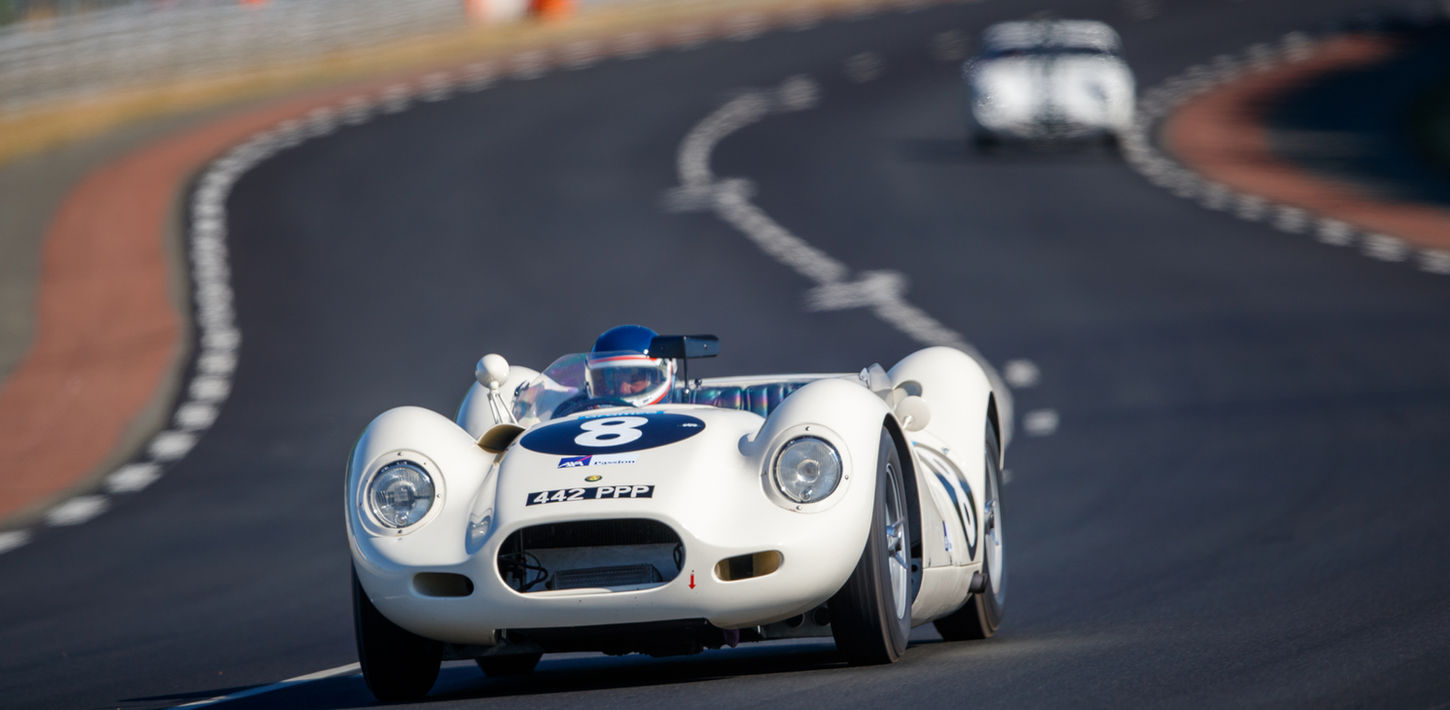Lister Jaguar Knobbly – The little English car with big teeth
In the late 1950s, the world of motor racing was dominated by giants such as Ferrari, Maserati and Aston Martin. However, in a small workshop in Cambridge, a craftsman named Brian Lister had a bold dream: to beat the big names at their own game, with much more modest resources.
The beginnings – A craftsman takes on the giants
Brian Lister, the son of an industrialist, developed a passion for mechanics at an early age. After building a few prototypes with MG and Bristol engines, he realised that he needed a more powerful engine to compete with the big names in the Sports category. That's where Jaguar came in. The Coventry-based brand, fresh from its victories at the 24 Hours of Le Mans with the Type D, agreed to supply Lister with its legendary XK six-cylinder engine.
The combination was explosive: an ultra-light tubular chassis, aerodynamic bodywork designed by Frank Costin, and a reliable, powerful engine. In 1957, the Lister Jaguar Knobbly was born.
‘Knobbly’, an affectionate nickname
Its name was not official. In the paddocks, people began to talk about this ‘bumpy’ Lister because of its rounded shape and prominent wings. The bumps on the bonnet and around the wheels were not there for style: they covered the suspension and mechanics, designed solely for aerodynamic and mechanical efficiency. The nickname ‘Knobbly’ would remain forever.
A dazzling track record
In 1958, the Lister Knobbly established itself as the ultimate weapon in sports car racing in the United Kingdom. Archie Scott Brown, a driver of exceptional talent despite his physical disability, won race after race with this machine. He racked up victories in England and impressed on the continent.
Other big names took the wheel: Masten Gregory, Stirling Moss, Ivor Bueb, Innes Ireland... All praised its precise steering, powerful engine and stability in corners. On many British circuits, the Knobbly was virtually unbeatable.
Tragedy and a turning point
However, the glory was overshadowed by tragedy. In May 1958, during a race at Spa-Francorchamps, Archie Scott Brown lost his life in an accident. This tragedy deeply affected Brian Lister, who lost his star driver and friend. Although the team continued to enter its cars in races, the momentum was broken.
In 1959, the regulations changed and the competition became tougher. Lister tried to adapt with an even more streamlined bodywork (the ‘Costin’ model), but costs rose. At the end of 1959, the adventure in official competition came to an end.
Undimmed glory
Even though it was no longer on the official starting grid, the Knobbly never fell into oblivion. Collectors preserved a few examples, aware that they owned a piece of history. Each car, often hand-built and slightly different, became a cult object.
The comeback – Renaissance of the Knobbly
In the 1990s, enthusiasm for historic racing exploded. The Lister Knobbly reappeared on the circuits at events such as the Goodwood Revival and Le Mans Classic. The public rediscovered their unique silhouette, their throaty roar and their feline agility.
In response to this enthusiasm, Lister Cars decided in 2014 to restart production. Ten ‘continuation cars’ were built according to the original plans, templates and methods: tubular chassis, hand-hammered aluminium bodywork, tuned Jaguar XK engine. Even the sound is faithful to that of 1958.
A legend that lives on
Today, whether it's an original model or an official continuation, the Lister Knobbly continues to race. It can be seen battling wheel to wheel with Ferrari 250 Testa Rossa, Maserati 300S and Aston Martin DBR1 cars, as if time had stood still.
For the drivers lucky enough to drive it, it's a raw experience: no electronic assistance, no compromises, just pure mechanics and talent behind the wheel. It's a lesson in old-school driving, where every corner is earned through sweat and precision.
The Lister Jaguar Knobbly is more than a car: it's a symbol. A symbol of British audacity in the face of the big manufacturers, a symbol of a golden age of motor racing when creativity and courage could beat financial resources.
And as long as we see it emerge from a cloud of dust when braking at Woodcote or roar into the night at Le Mans Classic, we will know that this little English car with big teeth has never really left racing.
Lister Jaguar BHL 20 – 442 PPP
A survivor with an unbroken history
Among the few Listers produced between 1954 and 1959, the BHL 20 chassis occupies a unique place. Part of the latest generation of ‘little Listers’, it was sold bare in 1959 to officer James MacKreth and was initially fitted with MG mechanics and registered as 442 PPP on 7 October 1960.
Three years later, its destiny changed: David A. Knobbs replaced the modest MG engine with a 3.4-litre Jaguar six-cylinder, entrusting the chassis's transformation to tuner Ken Eaton. Under his expert hands, BHL 20 shed its frail appearance to become a true Lister Knobbly Jaguar, ready to compete with the big boys.
on soon left its mark on the bodywork: in the late 1960s, a crash seriously damaged the car, which was temporarily taken out of service. But in 1974, Jeremy Broad, a well-known figure in Jaguar XK circles, undertook its resurrection. Entrusted once again to Ken Eaton, it was fitted with a 3.8-litre Jaguar E-Type engine and returned to the racetrack. In 1976, during the Prescott Hillclimb, bad luck struck again: Broad crashed into a tree, severely bending the chassis.
This long enforced hiatus, punctuated by a succession of bodyworks – some dubious, others authentic Williams & Pritchard – never altered the car's continuity. The arrival of a genuine factory body, revealing the original colours beneath the paint, definitively anchored BHL 20 in its identity.
In 2005, Broad finally sold the car to Trevor Groom, a close friend of Norman Dewis and a well-known figure in Jaguar racing circles, who meticulously restored it to its ultimate configuration: a Lister Jaguar Knobbly, with its original chassis, authentic components (tanks, Girling brakes, Dunlop wheels, dashboard) and official papers, including the precious original ‘buff log book’.
It then changed hands and was brought to France by us, where it had several owners, all of whom entered it in Le Mans Classic, among other events.
The last owner undertook a meticulous restoration of the bodywork to revive its shape and give it the shine it has today. Fully serviced before Le Mans Classic 2025, it is ready to take to the track.
Today, BHL 20 is unanimously recognised as the only chassis legitimately bearing this number, its history having been confirmed by Doug Nye himself and clarified in the face of confusion by certain authors. It is a regular feature at the most prestigious historic events: Le Mans Classic, the British Grand Prix at Silverstone, and FIA championships dedicated to 1950s sports prototypes.
An unquestionable pedigree
Original BHL 20 chassis with registration number 442 PPP
Jaguar conversion by Ken Eaton in 1963
Successive owners: James MacKreth, David A. Knobbs, John Harper, Jeremy Broad, Trevor Groom, current one in France.
Significant accidents and documented reconstructions (late 1960s, Prescott 1976)
Knobbly bodywork by Williams & Pritchard with traces of factory paint
Period documents (log book, modern V5C, FIA/MSA passport)
Regular presence at major historic events
Conclusion
The Lister Jaguar Knobbly is more than a car: it is a symbol. A symbol of British audacity in the face of the big manufacturers, a symbol of a golden age of motor racing when creativity and courage could beat financial resources.


































































